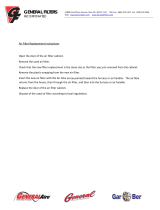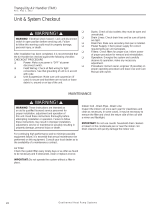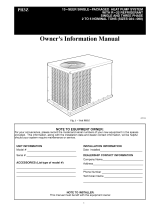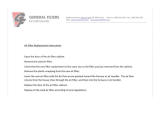
10
Air Circulation Check
Running the Blower Continuously
Set the thermostat’s system mode to OFF and the thermostat’s
fan mode to ON. The blower motor should run continuously.
Check for air delivery at the register(s). Make sure that there
are no obstructions at the registers or in the ducts.
System Cooling
1. Set the thermostat’s system mode to COOL and fan mode to
AUTO. Lower the thermostat’s temperature mode below room
temperature and observe that the blower energizes. Check
the air being discharged at the register is cooler than room
temperature. Verify unit refrigerant pressures are in order.
Blower should be turning in direction indicated by arrow.
NOTE: DO NOT alter unit wiring. Listen for any unusual
noises. Locate the source and correct as needed.
2. Allow the unit to run for several minutes and then set the
thermostat’s temperature above room temperature. Verify
the blower cycles off with the thermostat.
System Heating
1. Set the thermostat’s system mode to HEAT and the fan mode
to AUTO. Increase the thermostat’s temperature above room
temperature and observe that the blower energizes. Check
the air being discharged at the register is warmer than room
temperature.
2. Allow the unit to run for several minutes and then set the
thermostat’s temperature below room temperature. Verify the
blower cycles off with the thermostat.
Turning the Blower Off
Set thermostat’s fan mode to AUTO, the blower will shut down
immediately.
Blower Configurations
Selecting Minimum Electric Heat Airflow
The minimum electric heat airflow setting controls the minimum
air flow that will be produced whenever electric heater kits are
used. When the electric heater kit is energized along with a
heat pump, the airflow may be higher depending on the basic
cooling/heat-pump airflow setting. The minimum electric heat
airflow is selected by the red blower wire on 3-speed models or
setting switches 1,2,3 & 4 on MB7EM models. MB7VM models
automatically set the heating speed based on the amount of
installed heat. The A/B switch must be set appropriately for the
unit cabinet size. For C-sized cabinets, the A/B switch can be
set in either position. The remaining 3 HEAT switches have no
function. Switch settings are listed in Table 4, (page 14) &
Table 7, (page 15). NOTE: For MB7EM Models, the minimum
electric heat airflow setting may be set higher, but must never
be set lower than the setting shown in Table 6.
Determining Nominal System Capacity
To select the appropriate airflows for the air handler, the nominal
system capacity must be known. The nominal system capacity
is always the nominal capacity of the outdoor unit. However, in
some situations the nominal system capacity may not be the
same as the nominal capacity of the air handler. Always refer
to the nominal capacity of the outdoor unit to determine the
nominal system capacity.
NOTE: The CFM values listed in Table 7 are not dependent on
duct static pressure. The VSHE motor automatically compensates
for changes in duct static pressure (within the limits of the motor).
IMPORTANT! This air handler has been designed to give the
installer maximum flexibility to optimize system performance,
efficiency, and comfort. Because there are so many different
ways to set up the air handler it is important to read and follow
these directions carefully.
MB7EM & MB7VM air handlers use high efficiency circulating
air motors that come in two variations and both are controlled
differently. The fixed speed motor control board (Figure 12
(page 20)) controls the torque and the variable speed motor
control board (Figure 13 (page 20)) controls the airflow at a
constant CFM.
Before operation, the air handler must be configured to match
the unit with the system, system options, and climatic conditions.
During normal operation, the motor will gradually change speeds
during start-up, shut down, when thermostat inputs change, and
when the duct static pressure changes (vents closed or opened,
filter clogging, etc.). The air handler is configured by setting the
selector switches and removing jumper connectors.
Selecting Basic Heating Airflow
Fixed & variable speed motor control boards (Figure 12 & Figure
13) contain a set of dip switches for setting the blower speed.
For MB7EM models, pins 1-4 set the speed for heating. For
MB7VM models, the A/B switch must be set for the appropriate
cabinet size (either setting can be used for C-size cabinets).
The airflow is set automatically based on the amount of installed
heat. The cooling speed is selected via switches 5, 6, 7, & 8. To
determine the appropriate switch settings for your installation,
see Table 4, Table 5, Table 6, & Table 7.
Selecting Basic Cooling / Heat Pump Airflow
The basic cooling/heat-pump airflow is controlled by setting
switches 5 - 8 on the motor control board (mounted on the
blower). All airflows for other modes of operation (except electric
heat) are determined by this basic setting. FAN ONLY would
deliver 50% of the selected cooling airflow.
Table 6 lists the
basic airflow values recommended for each nominal system
capacity. To determine dip switch settings, refer to Table 4,
(page 14) for FSHE applications and Table 7, (page 15)
for VSHE applications.
• When operating in the heat pump mode, a higher basic airflow
setting will increase the energy efficiency and capacity but
will also decrease the supply air temperature.
• For maximum capacity and energy efficiency, select an airflow
at or near the top of the range for that nominal capacity. See
Table 6.
• For maximum dehumidification, select an airflow near the
middle or bottom of the range for that nominal capacity.
Additional information on humidity control can be found in
the Humidistat and Delay Setting sections.
• For thermostats with a dehumidifier output, use a field supplied
wire to connect the thermostat’s dehumidifier output to the
terminal marked DHUM. The thermostat should be set so
that the DHUM output should be high (energized) when
dehumidification is needed. See also Dehumidification Options
section.
IMPORTANT! If coil icing is observed, the basic cooling/heat-
pump airflow selected may be too low. Verify the setting selected
is within the range shown in Table 6 and that the the system is
properly charged. Please refer to the instructions supplied with
the outdoor unit. If icing continues to occur, raise the selected
airflow one or two steps.
NOTE: Variable speed air handlers with SEER ratings higher
than 15 are matched with a 2-stage cooling outdoor unit. They
are programmed to operate at 75% of the selected airflow while
the system is in the lo-cool mode and 100% of the selected
airflow while in hi-cool mode.























